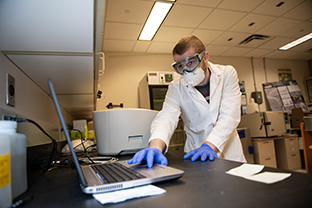September 17, 2020
$300K grant boosts SVSU researchers studying wastewater for traces of COVID-19
 A research team at Saginaw Valley State University secured an approximately $300,000 grant to continue its work searching for traces of the COVID-19 virus in wastewater samples collected from sites in Arenac, Bay, Huron, Iosco, Gladwin, Tawas and Saginaw counties. That testing – which includes sampling on the SVSU campus – could help alert health officials about potential outbreaks days before individuals display symptoms. The research also detects the virus in waste of people without symptoms.
A research team at Saginaw Valley State University secured an approximately $300,000 grant to continue its work searching for traces of the COVID-19 virus in wastewater samples collected from sites in Arenac, Bay, Huron, Iosco, Gladwin, Tawas and Saginaw counties. That testing – which includes sampling on the SVSU campus – could help alert health officials about potential outbreaks days before individuals display symptoms. The research also detects the virus in waste of people without symptoms. Since April, Tami Sivy, SVSU professor of chemistry, and two of her students have been developing methods for tracking existing and potential COVID-19 outbreaks by examining wastewater samples from across the region. With the support of a $300,000 grant from the state Department of Environment, Great Lakes and Energy (EGLE), the research team’s work will continue.
EGLE and the Michigan Department of Health & Human Services today announced the grant as part of a larger $10 million project that funds SVSU and other research teams monitoring wastewater for traces of COVID-19.
“There are a lot of universities scrambling to figure out how to do this research right now, and we are fortunate that we have been doing this for months,” Sivy said. “We’ve been ready.”
Among the communities benefiting from the SVSU research team’s work: Au Gres, Bad Axe, Bay City, Beaverton, Billings Township, Frankenmuth, Gladwin, Kochville Township, Midland, Saginaw Township, Standish, Sugar Springs and Tawas. The group also collects samples from wastewater at the Saginaw Correctional Facility in Freeland and Saganing Eagles Landing Casino in Standish.
Measuring communities’ COVID-19 levels via wastewater sampling is a method gaining demand nationally. SVSU is one of two universities in Michigan offering the cutting-edge research to communities, although other institutions are pursuing similar research offerings.
“This is a complimentary testing method,” Sivy said. “It isn’t meant to replace other methods like nasal swab testing, but when integrated into a community’s plan for monitoring the virus, it can perhaps help identify a potential outbreak before it spreads.”
Now that early detection could benefit the campus where she and her team perform their cutting-edge research. They began collecting samples on SVSU’s campus one week before students began moving into the university’s residential facilities in late August. The early sample allowed them to establish a baseline level that will help them better understand if more virus becomes present. The group is collecting new samples about three times per week.
Sivy said studies show tracing the COVID-19 virus through wastewater could reveal positive cases days before a person displays symptoms. That early detection in some scenarios could provide critical information earlier than other testing methods available to the general public. For instance, many individuals who experience COVID-19 symptoms seek nasal swab tests provided by health care professionals. SVSU usually receives nasal swab test results in 24 to 48 hours, but in other settings, the waiting period for nasal swab test results can be several days.
There already are examples where scientists credit wastewater research for preventing the spread of the virus, including at college campuses. After a wastewater sample at the University of Arizona indicated the presence of the virus, officials there individually tested 311 people living in a dorm suspected as the source, later identifying two asymptomatic students. Researchers at The University of Colorado Boulder also detected the virus early in wastewater samples.
The detective work is fascinating but not for weak stomachs, she said. Sivy’s team analyzes about 100 milliliters of wastewater – roughly one-third of a can of pop – collected from raw sewage outputs. Those small samples could contain traces of SARS-CoV-2 RNA – a result of the novel coronavirus – that may be present in the wastewater of the campus community.
If Sivy and her team discover an increase in traces of the virus, they could take measures to track the source to a more specific site. In the case of their research on campus, a rise in SARS-CoV-2 RNA levels could lead them to take samples from wastewater sites originating from specific buildings housing residential students, allowing them to narrow the potential source from thousands of students down to the hundreds or less.
“We can open a manhole from near the source and take a sample to see where it’s coming from,” Sivy said.
Information from the findings will be shared with local health departments including the Saginaw County Health Department, she said.
In performing the research, Sivy is supported by biochemistry majors Marc Dean of Port Huron; and Caleb Whittaker of Bay City. Since mid-April, the trio have worked in a Biosafety Level 2-certified, state-of-the art laboratory in the east wing of SVSU’s Herbert Dow Doan Science Building. Some of the grittier elements of the research process involve collecting wastewater samples. Bruce Hart, a lab technician at the university, performs that duty.
“He deserves recognition for this, too,” Sivy said.
She said SVSU’s status as one of the few institutions in the U.S. to perform the cutting-edge research – research that involves students in the process – shows the university’s commitment and value to the surrounding region.
“Through our work testing water quality at public beaches and other initiatives, we have been applying our expertise to protect public health for several years,” Sivy said.
“This is a natural extension of what we’ve been doing, and it’s something we at SVSU should be proud of.”
